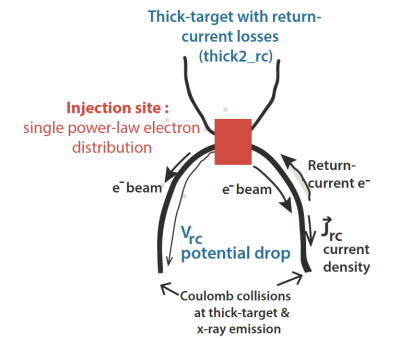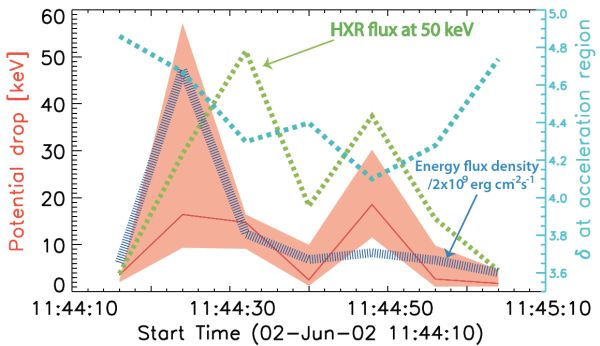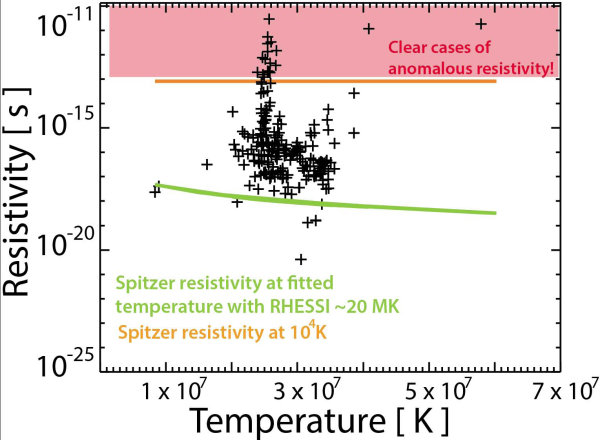Return-current Model Spectra and Enhanced Plasma Resistivity
| Nugget | |
|---|---|
| Number: | 259 |
| 1st Author: | Meriem Alaoui |
| 2nd Author: | and Gordon Holman |
| Published: | 31 August 2015 |
| Next Nugget: | |
| Previous Nugget: | Cosmic rays and the coronal B field |
Introduction
Solar flares involve sudden brightening across the whole range of the electromagnetic spectrum, and in particular the hard X-ray emission has proved to be a crucial factor in deciphering flare physics. The most common hard X-ray emission is an "impulsive" source that seems to define the main energy release of a flare, although other more gradual energy releases may also take place. The hard X-rays come from bremsstrahlung, a very inefficient emission mechanism, and the mere existence of hard X-ray sources implies a large amount of energy in energetic electrons.
The "number problem"
In the late 1970's several authors estimated the number of electrons in the downward-streaming beam thought to be required to explain the observed X-ray bremsstrahlung emission, and concluded that it must be several orders of magnitude higher than the number of electrons in the active region corona, where the acceleration would take place. This has been referred to as the electron number problem in solar flares: (1) Where do all the electrons come from that produce the bremsstrahlung emission, which may last from a few seconds to a few minutes? (2) What keeps the electron beam stable to charge separation and magnetic pinching? A co-spatial return current has been proposed to answer these questions. This current would flow in the opposite direction to the direct current created by the downward-streaming electrons. We consider it here as co-spatial and steady-state, serving to resupply the acceleration region with electrons from the thermal background and also to ensure that the beam is stable. The return current affects the shape of the X-ray spectrum by creating a flattening at lower energies due to a potential drop from the acceleration region to the thick target (Ref. [1]), where electrons are collisionally stopped and generate bremsstrahlung. In the following, we tested whether a return-current model can provide acceptable fits to the RHESSI spectra. Note that an earlier Nugget deals with related aspects of these problems.
We have found (Ref. [2]) that spectra with strong breaks can be fitted with a return current model. We fitted 206 spatially integrated spectra from 16 RHESSI flares with a co-spatial return-current model to deduce the potential drop that drives the return current and causes the spectral flattening. This fixes the injected spectral index, the electron flux at 50 keV, the low-energy cutoff and any high-energy cutoff at injection. We then deduce plasma parameters such as the resistivity. This resistivity was found to be up to eight orders of magnitude greater than the classical resistivity deduced from temperatures obtained from the RHESSI spectral fits!
Return current collisional thick-target model: the RCCTTM
The assumptions of the model are as follows:

3. Fitted parameters and resistivity in the plasma
We find that the RCCTTM provides good fits to RHESSI spectra with strong breaks or flattenings at lower energies. Figure 2 shows fit parameters from the flare SOL2002-06-02. The fit parameters of our return current model (currently in RHESSI's OSPEX software under "thick2 rc") are the return-current potential drop, the spectral index from the acceleration region, the electron flux at 50 keV, and the low-energy cutoff. This was a rare case for which a high-energy cutoff significantly improved the spectral fits in four time intervals.

An interesting parameter is the resistivity, which we deduce from the potential drop and the electron flux density using Ohm's law, with the electric field given by the potential drop and the loop half-length, and the current density given by the electron flux density (we estimate the source sizes from RHESSI images of the loop and footpoint area). We proceeded then to compare this inferred resistivity with the theoretical Spitzer resistivity at the temperature derived from the RHESSI spectral fits and at a much lower, chromospheric, temperature. The Spitzer resistivity is due to electron-ion collisions and is proportional to T-3/2.
Conclusions
In Ref. [2] we describe this project in more detail, and draw the following basic conclusions.
References
[1] "Understanding the Impact of Return-current Losses on the X-Ray Emission from Solar Flares"
[2] Alaoui & Holman (article in preparation) "Understanding X-ray spectra: Evaluation of a co-spatial return-current model."
